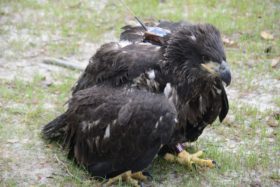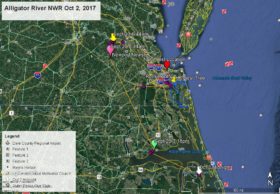Mobbing – What Is Going On ?
Happy New Year 2012
January 1, 2012Azalea in First Landing State Park
January 3, 2012Do you wonder what all the raucus noise is about and why there are swarms of birds chasing a raptor? That action is called mobbing. It is often the best way a birder can locate a raptor. Mobbing is sometimes triggered by no more than the shape of a raptor rather than any immediate threat. A raptor may be set upon by a single bird or by a large mob. For example, in 2006 when the first eaglet fledged from its nest at Norfolk Botanical Garden several of us were there. What started as one crow chasing this fledgling on its first flight was soon nearly 100 crows that came from every direction. For that eagle, harassment by crows and other birds was now to be the way of life. They will sometimes sit and tolerate the frenzied attack for a time, but will soon fly away to escape the attack usually without any retalitation. Mobbing is not completely understood but the attacks and vigorous vocalization is believed to encourage the “enemy” to move on, and occurs most often during breeding season. Sometimes several species will combine their efforts to drive off an intruder into their territory. Mobbing occurs among many species of birds, not just raptors.
These photos were taken on the North Landing River near Honey Bee Golf Course in Virginia Beach over the past few weeks showing juvenile eagles being harassed by crows. The red-tailed hawk was being dive-bombed by a crow that was nearly the same size, and responded by screaming but also flew off to get away from the scolding crow. (Photos copyright by Reese F Lukei Jr)









11 Comments
Amazing photos! This site is always such an education! Thanks, Reese.
Fascinating info! Thanks!
“Mobbing” …. but seems like bullying too! 🙂 Guess whatever works will do…
This will be an interesting warm-up discussion for my students during our next anti-bullying session.
Response – Interesting what we can learn from our animal cousins.
I have frequently observed this and always wondered what the behavior was all about. Very interesting.
Once witnessed a group of backyard birds (jays, cardinals, robins, mockingbirds) “mobbing” a single crow. But, alas, the crow still managed to take a baby robin from the nest in the pine tree. Will never forget that. Nature can be so sad, sometimes. 🙁
Wonderful pics and very informative as usual. Thank you! I have a question about another topic however. What are the band letters of the 2007 eagles? I saw a timeline on the NBG website and it gave the letters on other years but not 2007…have any of those eagles been seen..wouldn’t they have almost totaly white heads and tails….maybe the banded adult at Honeybee? Thanks for all you do!
Response – We did band the 2007 NBG eaglets, but not with color bands. We did not have them at the time. We have not seen any of those three eagles, and yes they would have almost completely white tails and heads. We have been able to read part of the band number on the Honey Bee adult and it is not from NBG, but may be another eagle I banded locally.
Just this morning I left the house for work and heard/saw several jays and mockingbirds carrying on and flying agitatedly. Figured there was a cat close by and looked up from unlocking my car to see if I could chase it off. Much to my surprise, on a branch not more than 8-9 feet from the ground and 4-5 feet over from me was a red-tailed hawk! Just sitting there looking very exasperated.
I stepped over to see if an injury was keeping it from perching higher or leaving the scene. As I got within a foot of its perch, it started to take off…and I realized these annoying little birds were totally capable of telling the larger hawk what to do and where to go. Poor hawk couldn’t get altitude without getting bonked and it ended up on my front porch perched on the hanging fern basket. The little birds sat in the tree daring the hawk to try to take off again. After a couple more minutes of the harrassment, I took off my coat and ran at the tree, flapping madly. The little birds startled and the RTH took off and gained altitude. The jays tried to follow, but the hawk finally had the altitude to get away.
Response – Thanks for sharing. Good example of a raptor being set upon by a mob of birds.
It’s always been fascinating to me to see this behavior and wonder why the sometimes much larger raptor tolerates the crows when there may be only one or two being a nuisance. Thank you for sharing this really interesting information…and your pics.
Thanks Reese. Great info (and sort of fun to watch, too!) and super shots.
I live in Brookline, MA and this summer I noticed a red tailed hawk for the first time, unfortunately trying to eat the squirrels I was feeding. Then several times I heard this loud screeching and watched two crows chasing the red tailed hawk all over the place.